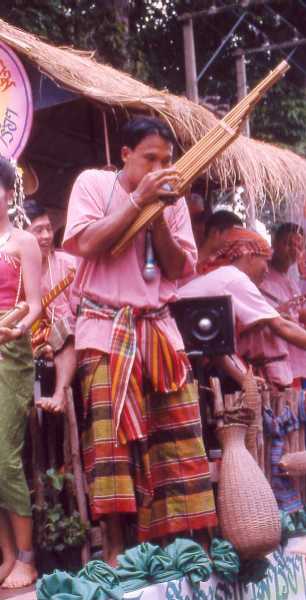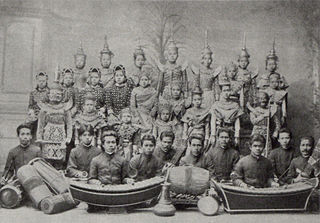
Evidence of modern human presence in the northern and central highlands of Indochina, which constitute the territories of the modern Laotian nation-state, dates back to the Lower Paleolithic. These earliest human migrants are Australo-Melanesians—associated with the Hoabinhian culture—and have populated the highlands and the interior, less accessible regions of Laos and all of Southeast Asia to this day. The subsequent Austroasiatic and Austronesian marine migration waves affected landlocked Laos only marginally, and direct Chinese and Indian cultural contact had a greater impact on the country.

The Lao people are a Tai ethnic group native to Southeast Asia, who speak the Lao language of the Kra–Dai languages. They are the majority ethnic group of Laos, making up 53.2% of the total population. The majority of Lao people adhere to Theravada Buddhism. They are closely related to other Tai people, especially with the Isan people, who are also speakers of Lao language, native to neighboring Thailand.

Lan Xang or Lancang was a Lao kingdom that held the area of present-day Laos from 1353 to 1707. For three and a half centuries, Lan Xang was one of the largest kingdoms in Southeast Asia. The kingdom is the basis for Laos's national historic and cultural identity.

Luang Phabang, or Louangphabang, commonly transliterated into Western languages from the pre-1975 Lao spelling ຫຼວງພຣະບາງ as Luang Prabang, literally meaning "Royal Buddha Image", is a city in north central Laos, consisting of 58 adjacent villages, of which 33 comprise the UNESCO Town of Luang Prabang World Heritage Site. It was listed in 1995 for unique and "remarkably" well preserved architectural, religious and cultural heritage, a blend of the rural and urban developments over several centuries, including the French colonial influences during the 19th and 20th centuries.
Traditional Lao music can be divided into classical and folk forms.

The khaen is a Lao mouth organ whose pipes, which are usually made of bamboo, are connected with a small, hollowed-out hardwood reservoir into which air is blown. The khene is the national instrument of Laos. The khene music is an integral part of Lao life that promotes family and social cohesion and it was inscribed in 2017 on the UNESCO Representative List of the Intangible Cultural Heritage of Humanity. It is used among the ethnic Lao Isan and Some tai ethnic groups such as Tai dam In north Vietnam and Lao population of the province of Stung Treng and is used in lakhon ken, a Cambodian dance drama genre that features the khene as the main instrument In Vietnam, this instrument is used among the Tai peoples and the Muong people.

The music of Thailand reflects its geographic position at the intersection of China and India, as well as historical trade routes including with Africa, Greece and Rome.

Mor lam is a traditional Lao form of song in Laos and Isan. Mor lam means 'expert song', or 'expert singer', referring to the music or artist respectively. Other romanisations used include mor lum, maw lam, maw lum, moh lam, mhor lum, and molum. In Laos, the music is known simply as lam (ລຳ); mor lam (ໝໍລຳ) refers to the singer.

Romvong, Lamvong or Ramwong, Rambung, Vietnamese: lăm-vông) is a type of Southeast Asian dance where both females and males dance in a circle. It is a popular folk-dance in Xishuangbanna (China), Cambodia, Laos, Malaysia and Thailand. It is a slow round dance continuously moving in a circular manner, and incorporates graceful hand movements and simple footwork. Both men and women participate in the same circle.

Laos developed its culture and customs as the inland crossroads of trade and migration in Southeast Asia over millennia. As of 2012 Laos has a population of roughly 6.4 million spread over 236,800 km2, yielding one of the lowest population densities in Asia. Yet the country of Laos has an official count of over forty-seven ethnicities divided into 149 sub-groups and 80 different languages. The Lao Loum have throughout the country's history comprised the ethnic and linguistic majority. In Southeast Asia, traditional Lao culture is considered one of the Indic cultures.

'Phra Lak Phra Ram' is the national epic of the Lao people, an adaptation of the ancient Indian epic Ramayana.
The dance and theatre of Laos is the primary dramatic art form of Laos' majority ethnic group, the Lao people. It is shared with the ethnic Lao that inhabit the Isan region of Thailand as well. There are mainly two types of dances, the classical dances performed in the royal courts and the folk dances now associated with morlam.

Christianity is a minority religion in Laos.

The gourd mouth organ is a free reed mouth organ played across East and Southeast Asia. It consists of a gourd wind chest with several bamboo or bronze pipes inserted on top of it, the numbers of pipes differing from region to region.

The Lao Rebellion of 1826–1828 was an attempt by King Anouvong of the Kingdom of Vientiane to end the suzerainty of Siam and recreate the former kingdom of Lan Xang. In January 1827 the Lao armies of the kingdoms of Vientiane and Champasak moved south and west across the Khorat Plateau, advancing as far as Saraburi, just three days march from the Siamese capital of Bangkok. The Siamese mounted a counterattack to the north and east, forcing the Lao forces to retreat and ultimately taking the capital of Vientiane. Anouvong failed in both his attempt to resist Siamese encroachment, and to check the further political fragmentation among the Lao. The kingdom of Vientiane was abolished, its population was forcibly moved to Siam, and its former territories fell under the direct control of Siamese provincial administration. The kingdoms of Champasak and Lan Na were drawn more closely into the Siamese administrative system. The kingdom of Luang Prabang was weakened but allowed the most regional autonomy. In its expansion into the Lao states, Siam overextended itself. The rebellion was a direct cause of the Siamese-Vietnamese wars in the 1830s and 1840s. The slave raids and forced population transfers conducted by Siam led to a demographic disparity between the areas that would ultimately become Thailand and Laos, and facilitated the "civilizing mission" of the French into Lao areas during the latter half of the nineteenth century.

Theravada Buddhism is the largest and dominant religion in Laos. Theravada Buddhism is central to Lao cultural identity. The national symbol of Laos is the That Luang stupa, a stupa with a pyramidal base capped by the representation of a closed lotus blossom which was built to protect relics of the Buddha. It is practiced by 66% of the population. Almost all ethnic or "lowland" Lao are followers of Theravada Buddhism; however, they constitute only 40-50% of the population. The remainder of the population belongs to at least 48 distinct ethnic minority groups. Most of these ethnic groups are practitioners of Tai folk religions, with beliefs that vary greatly among groups.

Phi Fa is a deity or spirit in the local folklore of Thailand and Laos. It is also known as Phi Thaen. They play a prominent role in the Phra Lak Phra Lam and the stories of Khun Borom.
Lao pop or L-pop is a music genre of pop music of Lao people.
The people of Laos have a rich literary tradition dating back at least six hundred years, with the oral and storytelling traditions of its peoples dating back much earlier. Lao literature refers to the written productions of Laotian peoples, its émigrés, and to Lao-language works. In Laos today there are over forty-seven recognized ethnic groups, with the Lao Loum comprising the majority group. Lao is officially recognized as the national language, but owing to the ethnic diversity of the country the literature of Laos can generally be grouped according to four ethnolinguistic families: Lao-Tai (Tai-Kadai); Mon-Khmer (Austroasiatic); Hmong-Mien (Miao-Yao), and Sino-Tibetan. As an inland crossroads of Southeast Asia the political history of Laos has been complicated by frequent warfare and colonial conquests by European and regional rivals.















